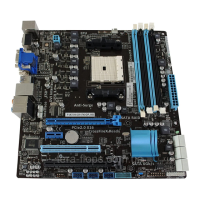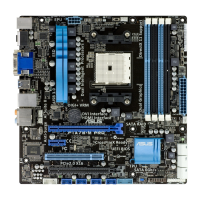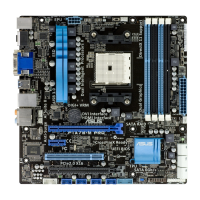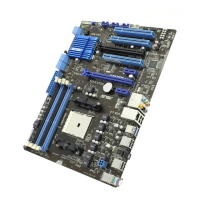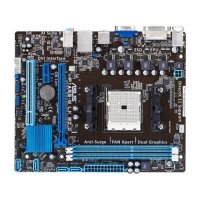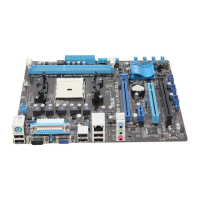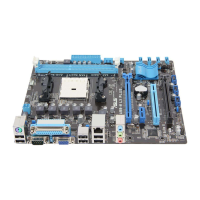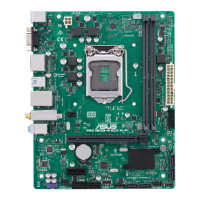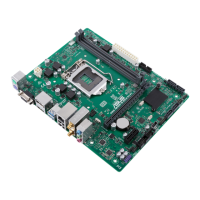Do you have a question about the Asus F1A75-M PRO R2.0 and is the answer not in the manual?
Guidance on handling and updating the system's BIOS.
Configures system boot options and device priorities.
Precautions to prevent electrical hazards during system operation.
Guidelines for safe handling and installation of motherboard components.
Details the structure and content of the user guide.
Resources for additional product and software updates.
Explains text formatting like bold and italics for clarity.
Details on the Accelerated Processing Unit and its features.
Information on RAM type, capacity, and speed supported.
Details on PCIe and PCI slots for add-on cards.
Details on USB ports, including USB 2.0 and USB 3.0.
Lists all components found in the motherboard retail package.
Overview of key features and technologies of the motherboard.
Explains ASUS's advanced power delivery and management system.
Details unique ASUS technologies like USB 3.0 Boost and UEFI BIOS.
Details on bundled software like AI Suite II and BIOS utilities.
Information regarding the motherboard's energy efficiency compliance.
Essential safety steps before installing components or changing settings.
Guidance on orienting the motherboard correctly within the chassis.
Instructions for using screws to mount the motherboard to the chassis.
Visual representation of motherboard components and connectors.
Detailed list of motherboard connectors, jumpers, slots, and LEDs.
Information about the FM1 socket and proper APU installation.
Step-by-step visual guide for installing the APU into the socket.
Instructions for mounting the APU heatsink and fan assembly.
Step-by-step guide for removing the APU heatsink and fan assembly.
Introduction to the motherboard's DDR3 Dual Inline Memory Module sockets.
Recommendations for installing memory modules and OS limitations.
Guidance on installing memory modules for single and dual-channel configurations.
Visual guide for correctly installing and removing memory modules.
Steps for physically installing an expansion card into a slot.
Adjusting BIOS settings and installing drivers after card installation.
Describes operating modes for PCIe slots with single/dual graphics cards.
Table showing IRQ allocations for various motherboard devices.
Instructions for clearing CMOS settings using the CLRTC jumper.
Identifies and describes all external connectors on the motherboard's rear panel.
Details audio port configurations and USB 2.0/3.0 port functions.
Location and function of connectors for CPU and chassis fans.
Details the Trusted Platform Module connector for enhanced security.
Explains the 24-pin and 8-pin ATX power supply connections.
Connectors for storage devices and RAID configurations.
Internal serial port connector for legacy devices.
Connectors for power/reset buttons, LEDs, and speaker.
Describes SPDIF and front panel audio connectors for sound output.
Location and function of internal USB 2.0 and USB 3.0 headers.
Utility for automatic memory compatibility tuning during boot.
Enables/disables the Turbo Processing Unit and Energy Processing Unit functions.
Indicates status of DRAM, TPU, and EPU functions via onboard LEDs.
Guidance on installing OS versions and ensuring compatibility.
Information on drivers, utilities, and software included on the support DVD.
Software for managing, saving, and updating the motherboard BIOS.
Methods for updating BIOS via internet connection or BIOS file.
User-friendly tool for updating BIOS without an OS.
Utility to recover corrupted BIOS files from DVD or USB.
Methods to access the BIOS setup utility at startup or after POST.
Introduction to the simplified BIOS interface for basic system information.
Details the advanced BIOS interface for detailed system configuration.
Detailed explanation of BIOS screen components like menu items and fields.
Configuration of system language, date, and time within the BIOS.
Options for setting administrator and user passwords for BIOS access.
Instructions for setting, changing, and clearing BIOS passwords.
Introduction to the Ai Tweaker menu for overclocking and performance tuning.
Settings for CPU overclocking, APU frequency, and DRAM profiles.
Configuring memory operating frequency and APU multiplier.
Automated overclocking and detailed DRAM timing adjustments.
Settings related to CPU features like C-states, PowerNow, and virtualization.
Configuring SATA channels, types (IDE/AHCI/RAID), and RAID ROM.
Settings for legacy USB support, USB 3.0, and EHCI hand-off.
Settings for integrated graphics, multi-monitor support, and frame buffer size.
Configuring HD Audio, front panel audio, LAN controller, and PXE ROM.
Settings for Asmedia USB 3.0 controller, charging, and serial port.
Configures system behavior after AC power loss and wake-up events.
Enabling/disabling UEFI network stack for IPv4 and IPv6 PXE boot.
Displays system temperatures, voltages, and fan speeds.
Displays CPU, motherboard temperatures and fan speeds.
Configures CPU fan speed control based on temperature profiles.
Adjusts chassis fan speed profiles and limits based on temperature.
Displays system voltages and enables/disables Anti Surge protection.
Configures NumLock state at power-on and full screen logo display.
Sets system behavior for error detection during the boot process.
Manages Option ROM messages and sets default BIOS setup mode.
Configures UEFI/Legacy boot modes and PCI ROM priority.
Stores and loads multiple BIOS settings for easy profile switching.
Shows Serial Presence Detect (SPD) information for installed DIMMs.
Option to load optimized default values for all BIOS parameters.
Options to save changes and reset, or discard changes and exit BIOS.
Details device compliance with Federal Communications Commission rules.
Information on compliance with Canadian ICES-003 and RSS standards.
Statements for Japanese VCCI and Korean KC compliance.
Details on REACH compliance and ASUS product recycling programs.
Provides addresses and contact details for ASUS technical support worldwide.
Formal declarations of product compliance with FCC and EC directives.
Guidance on handling and updating the system's BIOS.
Configures system boot options and device priorities.
Precautions to prevent electrical hazards during system operation.
Guidelines for safe handling and installation of motherboard components.
Details the structure and content of the user guide.
Resources for additional product and software updates.
Explains text formatting like bold and italics for clarity.
Details on the Accelerated Processing Unit and its features.
Information on RAM type, capacity, and speed supported.
Details on PCIe and PCI slots for add-on cards.
Details on USB ports, including USB 2.0 and USB 3.0.
Lists all components found in the motherboard retail package.
Overview of key features and technologies of the motherboard.
Explains ASUS's advanced power delivery and management system.
Details unique ASUS technologies like USB 3.0 Boost and UEFI BIOS.
Details on bundled software like AI Suite II and BIOS utilities.
Information regarding the motherboard's energy efficiency compliance.
Essential safety steps before installing components or changing settings.
Guidance on orienting the motherboard correctly within the chassis.
Instructions for using screws to mount the motherboard to the chassis.
Visual representation of motherboard components and connectors.
Detailed list of motherboard connectors, jumpers, slots, and LEDs.
Information about the FM1 socket and proper APU installation.
Step-by-step visual guide for installing the APU into the socket.
Instructions for mounting the APU heatsink and fan assembly.
Step-by-step guide for removing the APU heatsink and fan assembly.
Introduction to the motherboard's DDR3 Dual Inline Memory Module sockets.
Recommendations for installing memory modules and OS limitations.
Guidance on installing memory modules for single and dual-channel configurations.
Visual guide for correctly installing and removing memory modules.
Steps for physically installing an expansion card into a slot.
Adjusting BIOS settings and installing drivers after card installation.
Describes operating modes for PCIe slots with single/dual graphics cards.
Table showing IRQ allocations for various motherboard devices.
Instructions for clearing CMOS settings using the CLRTC jumper.
Identifies and describes all external connectors on the motherboard's rear panel.
Details audio port configurations and USB 2.0/3.0 port functions.
Location and function of connectors for CPU and chassis fans.
Details the Trusted Platform Module connector for enhanced security.
Explains the 24-pin and 8-pin ATX power supply connections.
Connectors for storage devices and RAID configurations.
Internal serial port connector for legacy devices.
Connectors for power/reset buttons, LEDs, and speaker.
Describes SPDIF and front panel audio connectors for sound output.
Location and function of internal USB 2.0 and USB 3.0 headers.
Utility for automatic memory compatibility tuning during boot.
Enables/disables the Turbo Processing Unit and Energy Processing Unit functions.
Indicates status of DRAM, TPU, and EPU functions via onboard LEDs.
Guidance on installing OS versions and ensuring compatibility.
Information on drivers, utilities, and software included on the support DVD.
Software for managing, saving, and updating the motherboard BIOS.
Methods for updating BIOS via internet connection or BIOS file.
User-friendly tool for updating BIOS without an OS.
Utility to recover corrupted BIOS files from DVD or USB.
Methods to access the BIOS setup utility at startup or after POST.
Introduction to the simplified BIOS interface for basic system information.
Details the advanced BIOS interface for detailed system configuration.
Detailed explanation of BIOS screen components like menu items and fields.
Configuration of system language, date, and time within the BIOS.
Options for setting administrator and user passwords for BIOS access.
Instructions for setting, changing, and clearing BIOS passwords.
Introduction to the Ai Tweaker menu for overclocking and performance tuning.
Settings for CPU overclocking, APU frequency, and DRAM profiles.
Configuring memory operating frequency and APU multiplier.
Automated overclocking and detailed DRAM timing adjustments.
Settings related to CPU features like C-states, PowerNow, and virtualization.
Configuring SATA channels, types (IDE/AHCI/RAID), and RAID ROM.
Settings for legacy USB support, USB 3.0, and EHCI hand-off.
Settings for integrated graphics, multi-monitor support, and frame buffer size.
Configuring HD Audio, front panel audio, LAN controller, and PXE ROM.
Settings for Asmedia USB 3.0 controller, charging, and serial port.
Configures system behavior after AC power loss and wake-up events.
Enabling/disabling UEFI network stack for IPv4 and IPv6 PXE boot.
Displays system temperatures, voltages, and fan speeds.
Displays CPU, motherboard temperatures and fan speeds.
Configures CPU fan speed control based on temperature profiles.
Adjusts chassis fan speed profiles and limits based on temperature.
Displays system voltages and enables/disables Anti Surge protection.
Configures NumLock state at power-on and full screen logo display.
Sets system behavior for error detection during the boot process.
Manages Option ROM messages and sets default BIOS setup mode.
Configures UEFI/Legacy boot modes and PCI ROM priority.
Stores and loads multiple BIOS settings for easy profile switching.
Shows Serial Presence Detect (SPD) information for installed DIMMs.
Option to load optimized default values for all BIOS parameters.
Options to save changes and reset, or discard changes and exit BIOS.
Details device compliance with Federal Communications Commission rules.
Information on compliance with Canadian ICES-003 and RSS standards.
Statements for Japanese VCCI and Korean KC compliance.
Details on REACH compliance and ASUS product recycling programs.
Provides addresses and contact details for ASUS technical support worldwide.
Formal declarations of product compliance with FCC and EC directives.
| Non-ECC | Yes |
|---|---|
| Internal memory | 64 GB |
| Memory channels | Dual-channel |
| Memory slots type | DIMM |
| Number of memory slots | 4 |
| Supported memory types | DDR3-SDRAM |
| Supported memory clock speeds | 1066, 1333, 1600, 1866, 2250 MHz |
| Processor socket | Socket FM1 |
| Processor manufacturer | AMD |
| Compatible processor series | AMD A, AMD E |
| USB 2.0 connectors | 10 |
| Number of SATA III connectors | 6 |
| USB 3.2 Gen 1 (3.1 Gen 1) connectors | 0 |
| PS/2 ports quantity | 1 |
| USB 2.0 ports quantity | USB 2.0 ports have a data transmission speed of 480 Mbps, and are backwards compatible with USB 1.1 ports. You can connect all kinds of peripheral devices to them. |
| Audio chip | Realtek ALC892 |
| Component for | PC |
| Power source type | ATX |
| Motherboard chipset | AMD A75 FCH |
| Audio output channels | 7.1 channels |
| Motherboard form factor | micro ATX |
| RAID levels | 0, 1, 10, JBOD |
| Supported storage drive interfaces | SATA III |
| Graphics card | Radeon HD 6000 |
| Parallel processing technology support | 2-Way CrossFireX |
| Ethernet interface type | Gigabit Ethernet |
| BIOS type | AMI |
| ACPI version | 2.0a |
| BIOS memory size | 64 Mbit |
| Width | 244 mm |
|---|
